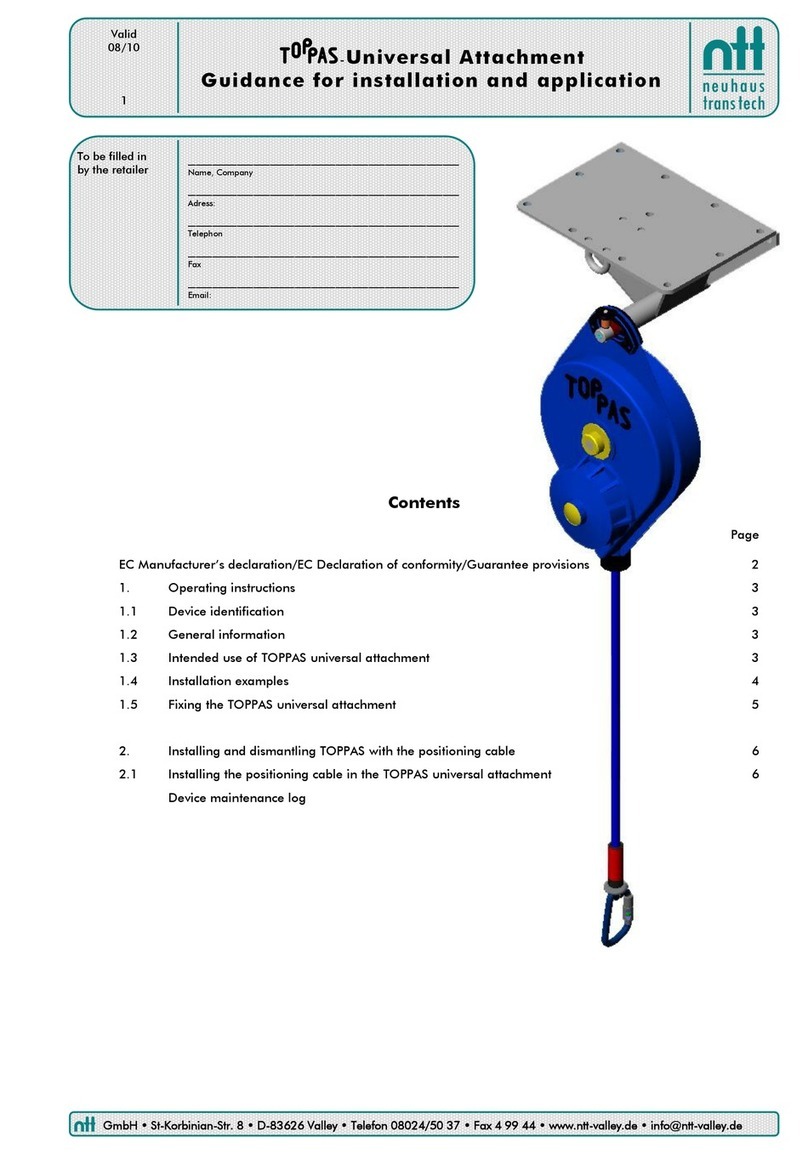1.3 Intended use of TOPPAS
The TOPPAS must be used for the intended purpose only in the technically flawless condition. In case of
faults or damage, the operation of TOPPAS must be stopped immediately and NTT must check it.
The operation inspection sheet must be updated daily
The operating company and/or the company must ensure that the user instructions have been understood
and are followed, are always accessible and at least a brief instructions sheet (pictogram) is affixed near the
installation site.
The supplier/manufacturer shall not be responsible for damage caused due to improper usage or
modification of the TOPPAS.
The TOPPAS functions as an effective system only in combination with an anchorage device and a personal
full body or climbing harness.
The TOPPAS does not hold the user, but allows him/her to descend in a decelerated manner. It therefore
does not provide protection against free falls, snagging, banging or bumping.
WARNING!
If the descent process is interrupted or if the user snags onto something, he/she should not
change his/her position even if it is uncomfortable.
The safety cable must remain tautly connected with the user. The carabiner should never be
disengaged and the safety cable should not be pulled out. A rescue operation must be initiated in
such a case. Only then can the protection against falls be ensured in such a situation.
If the retraction process is interrupted when climbing, i.e. if the cable attached to a person or a
device slackens, the climbing process must be stopped immediately. The aforementioned
information must be given to every user before starting the climbing process.
A safety and functional test must be conducted before using the TOPPAS each time.
Check whether the carabiner is clean and locks automatically with minimal effort
The braking effect must be noticeable when pulling the TOPPAS cable,
When retracting, the TOPPAS cable must be retracted completely using a tractive force of min
1 kg (without an auxiliary cable)
The cable should not slacken when climbing.
The entire section of the TOPPAS cable must be undamaged.
The completely spooled-in state indicates an out-of-use position. The TOPPAS cable should therefore not be
released freely, but in a controlled manner using an auxiliary cable and under pre-tension.
The auxiliary cable must be extremely light and should not be attached to the cable, the blue tube or the
grip sleeve, but to the carabiner
Twists in the cable may damage it
Depending on the load and condition, ntt must repair the TOPPAS at regular intervals, however
at least once a year. A carabiner may need to be inspected or replaced prematurely in case of
intensive usage (Checking the wear - see page 9) or due to other conditions (e.g. damage to the
cable, see page 10). Negligence could be fatal or lead to severe damage.
Only the certified anchorage points and anchorage device compliant with EN 795/12572 must be used.
These must be positioned perpendicular over the descent or landing area. The load bearing capacity of the
TOPPAS is 8 kN and 16 kN at a 180° deflection pulley.
TOPPAS may be installed only at such a height that a pull-out reserve of at least 2 m is always available
In case of a suspended arrangement, the TOPPAS must be attached at an adequate distance from the
climbing wall (minimum 200 mm) such that it is flexible in all directions. It must be ensured that the load is
transferred over the large area of the TOPPAS suspension and the deflections at the cable inlet and outlet
are minimal in all operating conditions. (Also see the instructions for installing the accessories)
Climbing grips must be procured and positioned such that no lateral, banging or oscillating movements are
possible in the upper section and the possibility of climbing over the TOPPAS is ruled out.
Deviating applications, installation positions, modifications or additions to the device unit must be checked
and approved by ntt in writing.
The distance between the TOPPAS and the landing area should not be greater than the maximum cable
length of the TOPPAS.




























